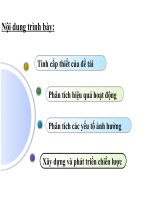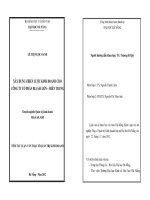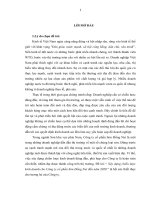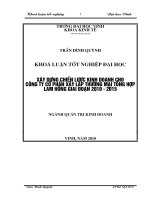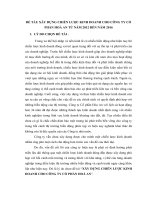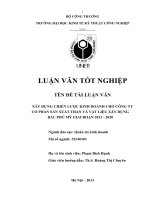Xây dựng chiến lược kinh doanh cho công ty cổ phần nhà và phát triển đô thị HUD tới năm 2020
Bạn đang xem bản rút gọn của tài liệu. Xem và tải ngay bản đầy đủ của tài liệu tại đây (508.26 KB, 58 trang )
Luận văn Thạc sĩ MBA
Xây dựng chiến lược kinh doanh cho Công ty cổ phần Nhà và Phát
triển đô thị HUD tới năm 2020
Thesis title
“BUILDING BUSINESS STRATEGY FOR HOUSING
AND URBAN DEVELOPMENT CORPORATION
(HUD) TO THE YEAR 2020”
Page 1
We would like to express our thankfulness to the lecturers, facilitators and experts
of VNU for your enthusiastic provision of very important information and knowledge
which help to equip us with new style and skills of management. The changes in thinking
and management style of ourselves and our colleagues, especially the effectiveness of the
management work at our office during the recent time, are wonderfully crystallized from
this important course.
Due to limited time, there are still some mistakes in the Project, even we commit
that this capstone project is result of our real study and practice in HUD Corporation. We
would therefore like to welcome all recommendations and comments to perfect our
Capstone Project on “Building business strategy to the year 2015 for the Housing and
Urban Development (HUD)”.
Thank you very much!
Page 2
TABLE OF CONTENTS
CHAPTER I...................................................................................................................... 9
KEY BASIC FOR A BUSINESS STRATEGY..............................................................9
1.1.Fundamental concepts of a business strategy..............................................................9
1.2.Strategy classification..................................................................................................9
1.3.Role of business strategy...........................................................................................10
1.4.Basis for building business strategy of an enterprise................................................11
CHAPTER II.................................................................................................................. 24
INTRODUCTION AND ANALYSIS ON THE HOUSING........................................24
AND URBAN DEVELOPMENT CORPORATION...................................................24
2.1. Establishment and development history of the Housing and Urban Development
Corporation (HUD)..........................................................................................................24
2.2.Analysis of the Corporation’s internal environment.................................................26
2.2.1.Human resources.....................................................................................................26
2.2.2.Financial resource...................................................................................................27
2.2.3.Technical – material facilities resources................................................................30
2.3.Analysis of external environment..............................................................................31
2.3.1. Analysis of macro environment.............................................................................31
2.3.2.Industrial environment............................................................................................37
CHAPTER III................................................................................................................44
BUILDING STRATEGY TO THE YEAR 2015 FOR HUD.......................................44
Page 3
3.1Oriented development.................................................................................................44
3.2 Objective of HUD......................................................................................................44
3.3.1.EFE Matrix of HUD................................................................................................44
3.3.2. IFE Matrix of HUD................................................................................................45
3.3.4.SWOT matrix of HUD............................................................................................46
3.6.Strategic solutions:.....................................................................................................51
3.6.1.Human resources solutions.....................................................................................51
3.6.2.Financial solutions..................................................................................................51
3.6.3.Marketing solutions:...............................................................................................51
3.6.4.Investment solutions:..............................................................................................52
3.6.5.Organization solutions............................................................................................53
3.7.The road map for implement strategy of HUD.........................................................53
Abréviations
WTO
HUD / HUD Corp.
PMU
World Trade Organization
Housing and Urban Development Corporation
Project Management Unit
AS
Attractive score
Page 4
LIST OF TABLES
Table 1.1: Strategy Management Model of F.David
Table 1.2: Model of 5 competitive forces of M. Porter
Table1.3: Competitors analysis
Table 1.4: Model of IE Matrix
Table 1.5: SWOT Matrix
Table 2.1: Strengths and weaknesses of human resources
Table 2.2: Capital Development Data
Table 2.3: Capital mobilization in 2008
Page 5
Table 2.4: Business results in recent years
Table 2.5: Financial figures of the last two years
Table 2.6: Strengths and weaknesses of financial sources
Table 2.7: Strengths and weaknesses of technical and material facilities
Table 2.8: Vietnamese GDP rate in recent years
Table 2.9: Opportunities and threats for HUD
Table 2.10: Factors affecting demand for real estate
Table 2.11: Opportunities and threats of industry analysis for HUD
Table 2.12: Competition criteria of HUD’s competitors
Table 3.1: External Factors Evaluation Matrix of HUD
Table 3.2: Internal Factors Evaluation Matrix of HUD
Table 3.3: I.E Matrix of HUD
Table 3.4: SWOT Matrix
Table 3.5: Scoring criteria of strategy
Table 3.6: Roadmap for making business strategy
INTRODUCTION
Circumstance, necessity and significance of the Project
The economy of Vietnam is a market economy with the State management and the
tendency to integrate into the global economy. To exist and develop, every enterprise
needs to have a strategy which is compliant to the integration trend and the common
market development. An enterprise without a good business strategy is like a boat without
sailing and a strategy which is incompliant or carried out badly cannot help that get
Page 6
success in the competition market. In other words, the destiny of an enterprise depends
much on the making and management of its business development strategy
The Housing and Urban Development Corporation (HUD) has been developing for 20
years. Its existence and development associate with so many changes of our country,
Vietnam. At the moment, HUD Corporation is one of the leading corporations of Vietnam
in housing and urban development. To determine the correct business path for in the
future, HUD Corporation is having its urgent concern of building a long-time, suitable
and flexible business strategy to face the fluctuations of the business environment, to meet
the increasing demand for urbanization and housing, making contributions to the national
course of industrialization and modernization. With this current situation and contribute
the ideas to get HUD Corp. have the vision and direction in the very competitive
economic environment of , our group have chosen the Project “Building business strategy
for the Housing and Urban Development Corporation (HUD) to the year 2015”.
Study Objectives
With this capstone project, there are two objectives we would like to gain:
Firstly, to build the business strategy for The Housing and Urban Development
Corporation (HUD) based on the analysis of internal and external environment to realize
the current strength, weakness as well as the threats and opportunities, which have
influence on the Corporation.
Secondly, to propose measures to implement the suggested business strategy for HUD.
Study method
In the study process, the capstone project uses the method of analysis and summary all
the real information from the Housing and Urban Development Corporation, the specialty
books on Strategy Management, Marketing, and Finance, the magazines, newspapers and
internet information.
The Group has also conducted an investigation and collected the ideas and opinions of
some individuals, organizations about the Housing and Urban Development Corporation and
other current competitors in the market. All the collected investigation papers, we use the
method of statistic and summarization to form it in the project.
Besides that, our group also uses the comparison method, industry analysis and
Page 7
enterprises’ activities to gather and combine them with theory, reality to build the vision and
strategy in the housing and urban construction industry.
Study object
The Project learns about theoretical and actual issues in the process of building the
strategy of the Housing and Urban Development Corporation.
Study Scope:
Studying fundamental basis of the making of the business development strategy in
a Corporation trading civil.
Studying the actual business development strategy of the Housing and Urban
Development Corporation (HUD).
Recommendations to complete the business strategy for the Housing and Urban
Development Corporation (HUD).
Structure of the Project Report:
The report includes three chapters:
Chapter I:
Key basis for the business strategy
Chapter II:
Introduction and analysis of the Housing and Urban Development
Corporation (HUD)
Chapter III: Building the business strategy to the year 2015 for the Housing and Urban
Development Corporation (HUD)
Page 8
CHAPTER I
KEY BASIC FOR A BUSINESS STRATEGY
1.1. Fundamental concepts of a business strategy
The term of “Strategy” was used firstly in the military from the years of Sixty of
Twenty century. This term was applied in the business field and from that “Business
Strategy” was initiated. However, the business strategy is being understood by the
management peoples with the different ways. This is due to the approaching ways to business
strategy of them are different.
Chandler defined strategy as “identification of the basic long term goals and
objectives, application of a set of actions and the allocation of necessary resources”
(Chandler, A. (1962). Strategy and Structure. Cambrige Massacchusettes. MIT Press)
According to Fred R.David (2003), strategy is the means to achive the long-term
targets.
Pursuant to Rudolf Grunig and Richard Kuhn (2003), strategy is long-period
management direction to aim the accomplishment the goals, main purposes of an
enterprise in long-term.
However, with many different ways and methods of understanding and approching,
business strategy is implying the followings meanings:
- Determining the maind and longterm target of an enterprise
- Drawing the general programs of actions
- Choosing the action plan, deploying to allocate the resources to implement that
target.
1.2. Strategy classification
According to Ms. Nguyen Thi Lien Diep and Mr. Pham Van Nam (1997, Strategy and
business policy), in the forming process of strategy, there are some types of it:
- Company-level strategy: It is a model decided in a company. This strategy to
determine and draw clearly the targets, aims of a company, what is company
pursuing and from that to create the policies and plans to achieve the target.
Page 9
- Business-level strategy: It is strategy to aim to define the products or market for
particular business activities for company. Each units of business department will try
to fulfill their target to contribute the accomplishment of company’s goal
- Function-level strategy: This strategy is concentrating on the supporting of strategy
organizations, co-ordination fields and business area.
1.3. Role of business strategy
Business strategy plays an important role in the company’s process of existence and
development. The details are followings:
Firstly, strategy is a tool to summarize all the long term targets of company. The target
of company is the specific goad which company wants to achieve in the process of business
activities. The concretization, documentation all the company’s targets through the strategies
help the members of company to know where they are going to, what do they need, what do
they need to do. This to help the company to complete the target very clearly
Secondly, strategy attaches with the short- term development target in the long- term
circumstance. In the modern business environment, almost companies should move actively
and flexibly to the business environment. However, the movement may be deviatory and
destroy the long – term development. That’s why strategy is very important and it creates the
long – term orientation.
Strategy also contributes to the ensure the unity and orientation of the company’s
activities. In the history of existence and development, with strong allocation labor trend both
in width and depth, all the works is being done in many different departments. That
specialization help to increase the effectiveness of the work, however, that department just
care to improve business activities of itself only but not take care to other’s one and whole
company’s. Therefore, some activities may be an obstacle to each others and cause badly to
company’s target. Strategy will provide comprehensively and systematically in the problem
solving in the reality to create the general strength of whole departments, whole members in
the company. From this it goes in one direction as company’s goal.
Page 10
Lastly, strategy helps the company to catch the market’s opportunities and compete
with other companies. Its units the process of activities to gain the purpose and duty.
Therefore, it help to improve effectively all the internal resources of company.
1.4. Basis for building business strategy of an enterprise
The strategy management is usually studied and used through many models. The
model of F.David seems to be widely applied and it shows as below:
Evaluation
externally to
point out the
opportunities
and threats
Give out the
long-term
target
Put the
normal target
Page 11
Mention
the current
duty,
target, and
strategy
Review the
company’s
duties
Evaluation
internally,
point out the
strengths and
weakness.
Measure and
assess
performance
level
Allocate
resources
Chose the
strategy to
pursue
Define the strategy
Policies of
departments
Perform the strategy
Assess the strategy
Table 1.1. Strategy Management Model of F.David
(Source: Overview about strategy management - National Economy University)
1.4.1. Analysis of external environment
External environment is the system of complex elements, with many chances and
threats which affect to activities of the company in different levels. Even though the scale
of potential resources is very high, company may not reflex to all happenings in the
market. Therefore when analyzing the external elements, the management people want to
develop a list of opportunities in the environment which can bring the benefit to the
company and all the threats, which company need to have solution to prevent or avoid
External environment includes the general environment and industry environment.
.
1.4.1.1 General environment.
PEST model studies the elements which affect to company includes political and
law environment, economic environment, socio-cultural and technological environment.
Page 12
Firstly, political environment and law have more and more influence to the
activities of a company. The influence of politics and laws means the government gives
out the legally regulations for enterprises to follow or prohibit. The Government is
playing the high role in the macro economy through the economic, financial, monetary
policies. In the relation with company, the Government is the key person to control,
encourage, support, regulate, prohibit and constrain.
Beside the political issues, the economic elements influence directly and actively
to the enterprise. Economic factors includes the trend of GPD, growth rate, interest rate
and trend of interest rate, international payment, trend of exchange rate, inflation, tax rate
and tax system, the fluctuation in the stock market, economic cycle and economic period
Social - cultural factors is the third in the PEST model. It includes the main
elements such as ethical conception, the thought of life standard, custom, habits, the
priority, care, awareness, intellectual of society. All of these factors have influence on
activities and companies. Therefore, company needs to pay attention to them when
building the business strategy
Technology environment is the fourth in the PEST model. It has always been
changing because it brings many chances to enterprise as well as the threats. Changes in
technology affect many sides of the society mainly through the products of technological
process. These include activities relating to the creation of new knowledge, moving the
knowledge into the output, the products, the processes and new materials. The change in
technology environment brings about the enterprise both opportunities and threats. The
opportunities are improving the ability to create the new products with high competitive
capacity; the threats are they can make the life circle of a product regress directly or
indirectly. The most important effect of the technological change is to affect the height of
the barrier and restructure the profession.
Beside PEST model, there are some more factors to impact to company, which is
the demography and globalization.
Page 13
Demography environment includes issues relating to population, age structure,
geography distribution, community of peoples and income distribution. Points of view
about consuming goods and services of people in the areas, and points of view of each
gender, age, profession affect the formation of the markets and also affect economic
strategy. Life styles affect the demand on goods and services including kinds, quality,
shape, design. The speed of population growth positively affects the strategy content of
the enterprise.
Globalization is the trend to integrate and globalize in and out Vietnam makes
enterprises think of international factors when they determine long-term strategy with
high integration and ability to develop geographically and politically. Global segments
include relating global markets, changing markets, important international political issues,
basic institutional and cultural property in international markets.
1.4.1.2. Industry environment.
The Five Pressures Model of Michael E.Porter (1985) is applying to analyze the
industry environment of enterprise. According to M. Porter, there are five competitive
forces in the profession: (1) risk of the coming of new companies (potential competitors);
(2) competitiveness among existing companies; (3) the strength of customer bargain
(Customer pressure); (4) Strength of seller negotiation (Supplier pressure); (5) Threats of
replaceable products.
M. Porter shows that the stronger those forces are, the more they limit the
companies in increasing the price and gaining higher profit. The task given is to realize
opportunities and threats which are given by the changes of five forces. From that, they
build up suitable strategies, changing the strength of one or more competitive resources
into their advantages.
Page 14
Potential
competitors
Competitors in the
industry
Suppliers
Customers
Substitutional
products
Table 1.2: Model of 5 competitive forces of M. Porter
(Source: Michael E.Porter 1985)
First of all, competitors are the highest pressure with any existed company. It can be
shown in the table below
Page 15
What do competitors
What is doing by
want to reach?
competitors and
Future purpose
what can they do?
Current strategy
In all levels of
How does the
managements
company compete?
Some issues needed to mentioned about the
competitors
- Do the competitors agree with the
current status?
-
How and what is the ability which
competitors move and change the
strategy
-
What is weakness of the competitors
-
What can help the competitors to
retaliate in the most strong and
effective way?
Consideration
Potential
Influence on
Strengths and
company and industry
weakness
Table1.3. Competitors analysis
(Source: Michael E.Porter 1985)
Beside competitors, the Supplier includes all the subjects such as suppliers of input
material, financial source and labor. The supplier may make threats against company the
price and payment method. The influence level depends on the concentration of the
supplier, the importance of the quantity of the products to the supplier; the difference
Page 16
among suppliers, the influence of input factors on the cost or the difference in products,
the change cost of the enterprises, the existence of replaceable suppliers, the threat of
unity of suppliers; supply cost against total profit of the profession
Customers decide the existence of company. The trust is the most value asset of an
enterprise. That trust can be reached because that company can satisfy the demand and
passion of customers better than competitors. Negotiation ability of the customers is
expressed as the buyers are regarded as a competitive threat when they require lower
prices or better services. The influence level depends on negotiation position, the quantity
of buyers, the information the buyers get, the special characteristics of the product brand,
the sensitiveness to the price, the difference in products, the concentration of customers in
the profession; the availability of replaceable goods, customer motivation, the integration
ability when the buyers can use threats of supply sources.
The new competitors to join the industry may also be the factor to decrease the
profit of company because they exploit and use the new production ability with the desire
to occupy the market share and necessary resources. Therefore, the protection the position
in the competition includes maintenance the legal barrier to prohibit the penetration from
outside. The legal barriers mainly include the economy of the scale (the effectiveness of
the enterprise, it gains experience when the scale is bigger), product diversification or
trademark loyalty (It is the buyers’ love for existing products as they believe those
products are special. A firm can create trademark loyalty by continuously promoting,
registering and protecting patent of its products; improving products’ quality through
research and development programs; strongly focusing on product quality and after sale
services. The trademark loyalty causes difficulties for new competitors who seek for a
market shares by entering the industry), high financial capital (Competing in a new
industry requires resources to invest. Beside the physical facilities, capital is needed for
critical business functions. The new entrants must consider the volume of required capital
if available to pursue the apparent market opportunity), switching cost (the cost of buying
Page 17
new equipment, of retraining employees and even the psychic costs of ending a
relationship, may be incurred in switching to a new supplier. A decision made by
manufacturers to produce a new, innovative product creates high switching cost for the
final consumers)
Lastly, the subsitutional products may reduce the potential profit of industry by
applying the ceiling price which other companies give out in their scale to have profit.
The influence level depends on changing cost when using products, the trend to use
replaceable goods from customers, balance of price and quality of replaceable goods. The
subsitutional products join market massive will increase the competition in the industry
and decrease the price and improve the quality.
1.4.2. Analysis of internal environment of company
Analysis of internal environment of company is a foundation to help company
realize their strengths, weakness compared with the competitors. Meanwhile, it helps the
management people to know their ability to catch up the advantage to compete in each
period. The internal function factors such as human resource, finance, marketing,
management board
1.4.2.1. Human resource
In the current changing business environment, human resource in a company is an
important part in the process of strategy competition and it decides the success or failure
of company. If there is a correct, perfect, potential and realistic strategy but human
resource in the organization is not skill enough to perform, so that strategy also not
effective.
1.4.2.2. Finance
Financial condition is considered as the assessment method of competition position
of company and it is the attractive condition of the investors. For building perfect
strategy, it is needed to determine the ability, weakness of company’s finance. It shows by
Page 18
some major financial figures such as liquidity, ratio of asset, equity, profit. This will help
to build the strategy and perform it better and more feasible.
1.4.2.3. Marketing
Studying the marketing to realize the market chances, market segments to choose
the targeted market and market orientation. Meanwhile, marketing will help to study the
customers and related factors to form the marketing orientation and competition
marketing. Through the marketing activities, company may design, organize to complete
and check the product, price strategy
1.4.2.4. Management
The management includes four major functions as forming, organizing, managing
and controlling.
The planning activities include all the matters to prepare for future. It is
forecasting, goal establishment, policy building and development, forming the plans.
The organizing activities include all the management activities to create the
relation between duties and responsibilities. They are organization resign, work
specialization, work description and details, control development, instruction unification,
co-ordination and work analyzing.
The leading activities consist of the efforts to orient the activities of people, in
details is connecting, managing with group, individuals, delegating, authorizing to
improve the working quality, satisfy the demand of company and staffs.
At last, the control activities relate to all operations to ensure the result correctly
and suitable with the plans.
1.5. Tools of building strategy and selecting strategy
1.5.1. Tools of building strategy
Come from the situation of Housing and Urban Development Corporation (HUD), the
suitable tool of building strategy as follows:
Page 19
1.5.1.1. Internal Factor Evaluation Matrix (IEF)
Internal Factor Evaluation Matrix is the tool to summary and evaluates the
strengths and weaknesses of SBU. It brings the base to determine and estimate the
relationship between these units.
According to Fred R.David, IFE matrix can be built by 5 steps as follows. Step one
is listing the factors determined in the internal evaluation, using 10 to 20 factors,
including strengths and weaknesses.
Step two is fixing the importance by classifying from 0.0 (unimportant) to 1.0
(most important) for each factor. The importance of each factor expresses the importance
of it to the company success. Total score for the importance is 1.0.
The third step is classifying from 1 to 4 for each factor, for the largest weakness
marked 1, the smallest weak weakness marked 2, the smallest strength marked 3, and the
largest strength marked 4. This mark are built base on the evaluation of the internal factor.
Fourthly, step four is multiplying the importance of each factor with its
classification in order to the find out the score of importance for each factor.
Lastly, the step five is that plus all the score of importance for each factor in order
to find out the score of importance of the company.
However the IFE consists many elements, the total mark may be classified the
lowest from 1.0 to the highest of 4.0 with the average point is 2.5. If the total mark is
below 2.5, it shows that company is weak inside and vice versa, the higher mark than 2.5
tell that the internal company is strong enough.
1.5.1.2.
External Factor Evaluation Matrix (EFE)
External Factor Evaluation Matrix (EFE) allows recapping and assessing the
information of economy, politics, culture, society, demography, geography, law,
technology and competition.
Page 20
According to Fred R.David, the forming EFE consists of five steps.
Firstly, step one is listing the elements which plays the decisive role on the success
of company as same as the internal factors evaluation. It may use ten to twenty elements
including the opportunities and threats to affect the company and the industry of
company.
The second step is classifying the importance level from 0.0 (not important) to 1.0
(very important) for each element. This classification tells the importance potion of them
to the success of business industry of a company. The suitable classification may be
determined by comparison the succeeded competitors with failed ones or by discussion
about these elements for agreement in the group. The total of classification must be 1.0
The third step is classification and marking from 1 to 4 for each decisive factor to
see the method which the current strategy reacts upon them, while mark one is low
response, two is average response, mark three is reaction above average, and four is good
reaction.
Next, step fourth is multiplying each importance level with that factor to determine
the total mark for each variable.
Lastly, the fifth step is adding all the marks to have the total mark of company.
Any factors of threats and opportunities inside the EFE matrix, total important
mark which company can have lowest is 1.0, highest is 4.0 and the average mark is 2.5.
The total mark is 4 shows that company response very good with their current
opportunities and threats in their industry environment. The total mark is 1 show that the
strategy which company suggested will not use advantage of opportunities or avoid the
external threats.
1.5.1.3 Matrix Internal - External (Matrix IE)
Matrix Synthesis of external factors, the internal factors is based on two main
aspects. They are total mark of important elements of the IFE matrix and total mark of
important points of the EFE matrix.
Page 21
The total mark of important elements of the IFE matrix is shown in X axis
The total mark of important elements of the EFE matrix is shown in Y axis
IE Matrix set parts of a business in a box of 9 as shown:
The mark of IFE
Strong
3.0 - 4.0
Medium
2.0 - 2.9
Weak
1.0 - 1.9
High
The mark of
3.0 - 4.0
EFE
Medium
2.0 - 2.9
Low
1.0 – 1.9
Table 1.4: Model of IE Matrix
IE matrix puts different SBU of a company in one table with nine boxes. They are boxes
of Development and construction – the blue box I, II, IV (appropriate strategy is to focus
growth (market penetration, market development, product development), hold and
maintain - the yellow box III, V, VII (appropriate strategy for market penetration and
product development), harvesting and remove - the red box VI, VIII, IX ( cuts, liquidation
or remove parts down inefficient operations).
1.5.1.4.
Matrix of strengths, weakness, opportunities and threats - SWOT
MATRIX
According to Nguyen Thi Lien Diep and Pham Van Nam (1997, Strategy and
business policy), to create the SWOT matrix, it is necessary to have eights steps:
Page 22
Step one is listing the main strengths inside the company
Step two is listing the main weaknesses inside the company
The third step is listing the big opportunities outside the company
The fourth step is listing the importance threats outside the
Lastly, step five is combination of strengths with external opportunities and listing
the result of SO strategy in suitable box.
The six steps is combination of weakness with external opportunities and listing
the result of WO strategy in suitable box.
Next, step seven is combination of strengths with external threats and listing the
result of ST strategy in suitable box
Lastly, step eight is combination of weakness with external threats and listing the
result of WT strategy in suitable box.
Opportunities (O)
Threats (T)
Strengths (S)
Listing the opportunities
SO Strategies
Listing the threats
ST Strategies
Listing the strengths
Use strengths to
Use strengths to restrict
take advantage
and
Weaknesses (W)
of the opportunities
WO Strategies
evade threats
WT Strategies
Listing the
Exploiting opportunity to fill seats
Overcome weaknesses
weaknesses of
weaknesses and overcome weaknesses
in order to reduce risk.
SWOT MATRIX
to take advantage of the opportunity
Table 1.5. SWOT MATRIX
1.5.2. Tools of strategy selections
1.5.2.1. Selection criteria:
To choose strategies for businesses that has identified the criteria chosen strategy to
ensure the requirements:
Strategically selected to ensure suitable environmental conditions; Compliance with
Page 23
foreign policy viewpoints and methods of management of Directors of the company;
Compliance with the financial capacity material and personnel of the enterprise.
1.5.2.2. Method of selection strategies
Using strategic planning matrix can be quantified (QSPM - Quantitative Strategic
Planning matrix)
Table 1.9 : QSPM - Quantitative Strategic Planning Matrix
Proportion
FACTORS
The internal factor
The external factor
Total
The strategies
Strategy 1
Strategy 2
A
B
A
B
...
A
Marks
B
B=A
1
S
S
S
x
proportion
The higher the total score S is the selection of more appropriate strategies and
implementation more effective.
CHAPTER II
INTRODUCTION AND ANALYSIS ON THE HOUSING
AND URBAN DEVELOPMENT CORPORATION
2.1. Establishment and development history of the Housing and Urban Development
Corporation (HUD)
The Housing and Urban Development Corporation (HUD Corporation) is a Stateowned corporation organized and operates according to the Decision No. 90/TTG dated
07 March, 1994 of the Prime Minister. The Corporation was established in 2000
(according to the Decision No. 08/2000/QĐ-BXD dated 02 June, 2000 of the Minister of
Page 24
Construction) from the Housing and Urban Development Company (which was
incorporated on 10 October, 1989 according to the Decision No. 843/BXD-TCLĐ of the
Minister of Construction)
Its main activities are:
Making investment and development of residential areas, urban areas, economic
zones and centralized industrial parks.
Providing consultant services on construction and infrastructure development of
urban areas, industrial parks.
Providing management services for projects on investment and development of
housing, new urban areas and industrial parks.
Making construction, installation of civil, industrial, transportation, irrigation, telecommunication works, and infrastructure of urban areas, industrial parks, lining and
power station projects, and water and electricity systems of civil and industrial projects...
Managing services in new urban areas, residential areas.
Having joint-venture and combination relations with foreign and domestic
organizations in investment and development of urban areas, residential areas and
industrial parks.
HUD Corporation has been working for 20 years, with the current growth and
financial accumulation development; it can carry out at the same time many big projects
in different areas. Its own equity has been increasing rapidly in the recent years, from
nearly one hundred and fifty (150) billion Vietnamese dong (equivalent to eight million
US dollar) in 2000 to over one thousand and eight hundred (1,800) billion Vietnamese
dong (equivalent to one hundred million US dollar) now.
The annual growth rate is high and stable with an average rate of over 20% for
production value, turnover and profits. Turnover from housing and infrastructure
development accounts for a great proportion. Till 2008, the Corporation has put into
Page 25

